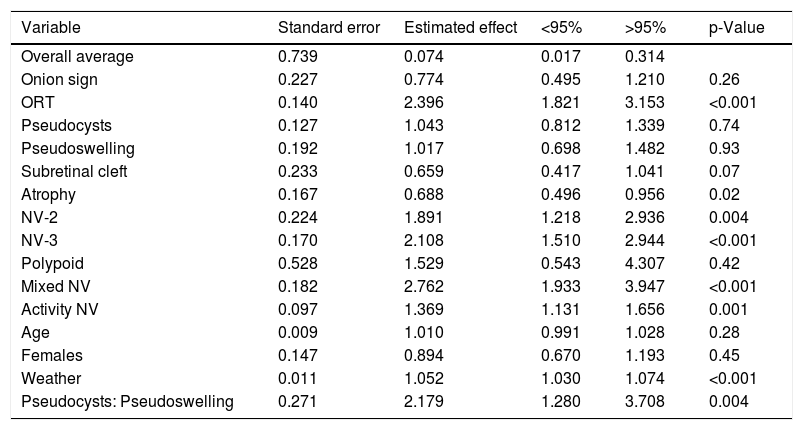To analyse the prevalence of non-exudative tomographic signs (onion sign, pseudoswelling, external retinal tubulation, pseudocysts, subretinal clefts and macular atrophy) in patients with neovascular age-related macular degeneration.
Material and methodsA total of 174 eyes of patients with neovascular age-related macular degeneration who had not received previous treatment were included in the study. Visual acuity, neovascularization activity, and the appearance or not of the different signs under study were assessed at times 0 (initial visit), 4 months, one year, year and a half, and at 2 and 3 years of follow-up. The following were also evaluated: age, sex, affected eye and type of neovascularization (1, 2, 3, polypoid or mixed). The analysis were performed using the statistical software R (version 3.3.2) and the glmmADMB package (version 0.8.3.3).
ResultsThe presence of pseudocysts and external retinal tubulation increases throughout the follow-up. The onion sign begins with an ascending frequency up to 12 months, then decreases at 18 months and increases again at 24 months. Regarding pseudowelling, it maintains an increase until 18 months to finally decrease. Subretinal clefts is the rarest sign, presenting in 1.1% on the first visit. Finally, macular atrophy, present in 12.6% of the eyes initially, is found in 25% after 2 years.
ConclusionPseudocysts, external retinal tubulation and macular atrophy were the most prevalent signs, while subretinal clefts were the most infrequent.
Analizar la prevalencia de signos tomográficos no exudativos (signo de cebolla, seudoedema, tubulación de la retina externa, seudoquistes, hendiduras subretinianas y atrofia macular) en pacientes con degeneración macular asociada a la edad neovascular.
Material y métodosUn total de 174 ojos de pacientes con degeneración macular asociada a la edad neovascular que no habían recibido tratamiento previo fueron incluidos en el estudio. Se valoró la agudeza visual, la actividad de la neovascularización y la aparición o no de los distintos signos objeto de estudio en los tiempos 0 (visita inicial), 4 meses, un año, año y medio y a los 2 y 3 años de seguimiento. Se evaluaron también: la edad, el sexo, el ojo afecto y el tipo de neovascularización (1, 2, 3, polipoidea o mixta). Los análisis se han realizado mediante el software estadístico R (versión 3.3.2) y el paquete glmmADMB (versión 0.8.3.3).
ResultadosLa presencia de seudoquistes y tubulación de la retina externa va en aumento a lo largo del seguimiento. El signo de cebolla comienza con una frecuencia ascendente hasta los 12 meses, posteriormente desciende a los 18 meses y vuelve a incrementarse a los 24 meses. En cuanto al seudoedema, mantiene un incremento hasta los 18 meses para finalmente descender. Las hendiduras subretinianas son el signo más raro, presentándose en el 1,1% en la primera visita. Finalmente, la atrofia macular, presente en el 12,6% de los ojos inicialmente, se encuentra en el 25% a los 2 años.
ConclusiónLos seudoquistes, la tubulación de la retina externa y la atrofia macular fueron los signos más prevalentes, mientras que las hendiduras subretinianas fueron los más infrecuentes.








